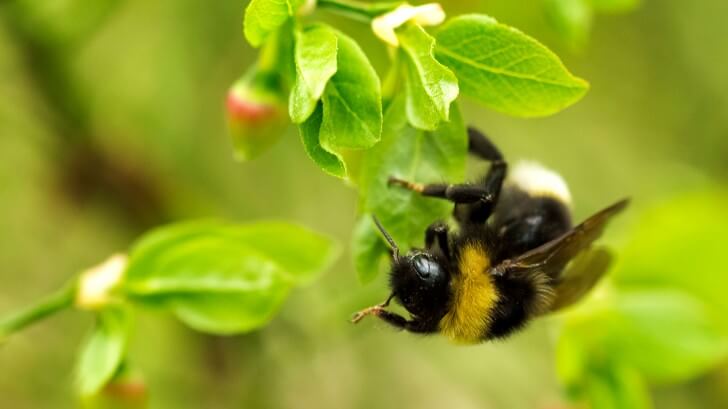BBC Earth newsletter
BBC Earth delivered direct to your inbox
Sign up to receive news, updates and exclusives from BBC Earth and related content from BBC Studios by email.
Insects
The perceived scourge of any picnic, the humble bumblebee has acquired an unwarranted reputation as a pest.
This misconception could not be further from the truth; they are more blighted than a blight themselves. Bumblebees are a key part of the food chain and their numbers are falling. Their loss will have a severe impact on future food supplies. Here are seven things you need to know to make you buzz about bumblebees.
There are about 275 different species of bumblebee. The UK has 24, of which eight are common. It's important to understand the features that set bumblebees apart from honey bees. Only one type of honey bee lives in Europe, Apis mellifera, mainly in human-managed hives of up to 60,000 bees. Bumble bees don’t make honey, they only produce a honey-like substance called nectar to feed the few hundred bees in their nest. Unlike honey bees, which dance to direct co-workers to good flowers, bumbles don’t appear to jive.

Bumblebees are not pests. They’re largely passive creatures who really have no interest in dive-bombing your picnic. Unlike honey bees, they can sting more than once, but unless you do something to upset them such as disturb their home, they rarely do so. A nest won’t damage property (they don’t guzzle wood like wasps) and don’t worry, if you see them crowding round a nest: there will be amorous males hoping to get lucky with the queen – and males can’t sting at all.
A bumblebee’s value lies in its pollination powers. For zero reward from us, they pollinate 80% of our wildflowers and 84% of crops. These voluntary workers contribute an estimated £510m per year to Britain’s economy. Particularly special are their ‘buzz pollination’ skills. Crops such as tomatoes, aubergines and kiwis hold tight onto their pollen and bumblebees are the only UK creatures that can get them to part with it - they vibrate their flight muscles to break it loose.

British bumblebee numbers have received an almighty swat in the last eight decades. Approximately 97% of the wildflower-rich habitats that once covered the landscape has vanished since the 1930s, due largely to modern farming methods and the expansion of towns. Both the Cullem’s bumblebee and the short-haired bumblebee have since become extinct, while the great yellow bumblebee and the shrill carder bee are now severely threatened.
Climate change is also putting pressure on bumblebee habitats as the insects don’t like heat. A 2015 study in Journal Science showed that warmer temperatures have reduced the southern-most areas they inhabit in Europe and North America by more than 300km in recent decades. Inexplicably, they have not compensated by moving up to colonise northerly areas, perhaps because habitats simply aren’t available, so they’re being squeezed into smaller latitudes.

Research has shown that insecticides could be causing bees to get rather confused. In December 2013 the European Union placed a two-year ban on three neonicotinoid pesticides (clothianidin, imidacloprid and thiamethoxam) widely used by farmers while more research is undertaken into their possible effects. Studies suggest they can harm bee neurones, causing them to lose their bearings and fail to return to their nests with vital food supplies.
The research, conducted by the European Food Safety Authority, found that overall all three of the neonicotinoids posed a threat to bees, however the different neonicotinoids affected types of bees differently. Imidacloprid, for example, was deemed to have a low risk to honey bees when they were exposed to it via the residues in the nectar and pollen from treated crops, but a high risk to bumblebees. On the 30th May 2018, the European Union renewed the ban on the outdoor use of the three neonicotinoid pesticides.
The short-haired bumblebee (Bombus subterraneus) is one of the two bumblebee species that Britain has lost in the past century. The last time a native individual was spotted here was in Dungeness, Kent, in 1988, and in 2000 the species was officially declared extinct. But in 2009, scientists began concocting a way to bring them back. Sourcing short-haired bumblebee queens from Sweden – the only country where the species is known to be self-sustaining – project manager Dr Nikki Gammans and her team brought them back to the UK with the aim of releasing them at Dungeness and on Romney Marsh.
In order for the bees to start a self-sustained population, they also needed a food supply. The project worked with farmers and landowners to recreate habitats rich in the bumblebees’ favourite flowers. The first annual release took place in 2012 and worker short-haired bumblebees were spotted the following year – proof the queens had nested. Even better, thanks to 70 farmers and 27 landowners transforming 1,200 hectares into flower-rich grasslands, other bees are buzzing back. Among them is Britain’s rarest bumblebee, the shrill carder bee, which has returned to the area after a 25-year absence.
‘It’s not just about the short-haired bumblebee. It’s the whole symbol of this bee, of what can go horribly wrong if we destroy an animal’s ecosystem,’ Dr Gammans explains. ‘The message is if you recreate the habitat and you manage it right, it really does work.’
Featured image © Rüdiger Katterwe | EyeEm | Getty